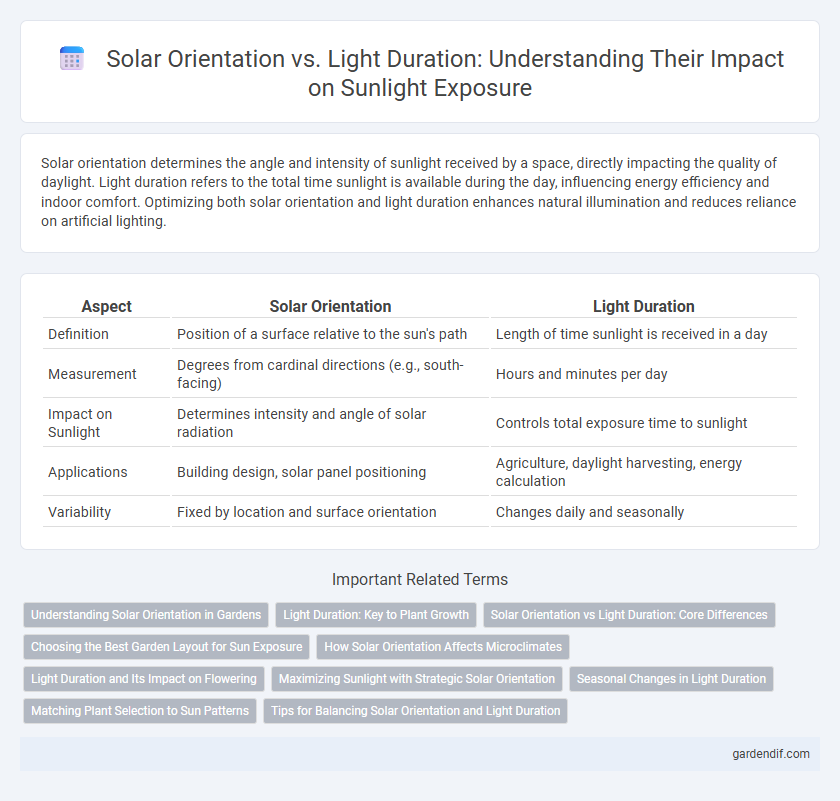
Solar Orientation vs Light Duration Illustration
Solar orientation determines the angle and intensity of sunlight received by a space, directly impacting the quality of daylight. Light duration refers to the total time sunlight is available during the day, influencing energy efficiency and indoor comfort. Optimizing both solar orientation and light duration enhances natural illumination and reduces reliance on artificial lighting.
Table of Comparison
| Aspect | Solar Orientation | Light Duration |
|---|---|---|
| Definition | Position of a surface relative to the sun's path | Length of time sunlight is received in a day |
| Measurement | Degrees from cardinal directions (e.g., south-facing) | Hours and minutes per day |
| Impact on Sunlight | Determines intensity and angle of solar radiation | Controls total exposure time to sunlight |
| Applications | Building design, solar panel positioning | Agriculture, daylight harvesting, energy calculation |
| Variability | Fixed by location and surface orientation | Changes daily and seasonally |
Understanding Solar Orientation in Gardens
Solar orientation in gardens determines how sunlight interacts with plant growth by influencing light duration and intensity throughout the day. Gardens oriented toward the south in the Northern Hemisphere receive the longest exposure to sunlight, promoting photosynthesis and healthy development. Understanding the sun's path allows gardeners to optimize planting locations, ensuring species requiring more light thrive, while shade-tolerant plants are placed accordingly.
Light Duration: Key to Plant Growth
Light duration directly influences photosynthesis, regulating the growth cycle of plants by determining the length of time they receive energy for metabolic processes. Extended exposure to sunlight enhances chlorophyll production, boosting nutrient synthesis and accelerating development in species such as tomatoes and corn. Optimizing light duration based on solar orientation maximizes photosynthetic efficiency, essential for improving crop yield and plant health.
Solar Orientation vs Light Duration: Core Differences
Solar orientation refers to the specific angle and direction at which sunlight strikes a surface, crucial for maximizing solar energy absorption or optimizing natural lighting. Light duration, however, indicates the length of time a surface or location receives sunlight during a day, influenced by Earth's axial tilt and seasonal changes. The core differences lie in solar orientation's focus on spatial positioning for light intensity versus light duration's emphasis on temporal exposure and daylight length.
Choosing the Best Garden Layout for Sun Exposure
Optimizing solar orientation in garden design maximizes light duration, enhancing plant growth and energy efficiency. South-facing layouts capture the longest sunlight exposure throughout the day, ideal for sun-loving crops and flowers. Strategic placement based on solar angle ensures consistent light duration, improving garden yield and health.
How Solar Orientation Affects Microclimates
Solar orientation significantly influences microclimates by dictating the intensity and duration of sunlight an area receives, which affects temperature variations and humidity levels. South-facing slopes in the Northern Hemisphere capture more sunlight, creating warmer and drier conditions compared to north-facing slopes that remain cooler and moister. This variation in solar exposure drives diverse plant growth patterns and localized weather phenomena within small geographic areas.
Light Duration and Its Impact on Flowering
Light duration, or photoperiod, plays a crucial role in the flowering process of many plants, affecting the timing and development of blooms. Extended exposure to sunlight triggers biochemical changes that activate flowering genes, influencing whether plants are classified as short-day, long-day, or day-neutral species. Understanding the interaction between solar orientation and light duration enables optimized cultivation strategies to enhance flower yield and quality.
Maximizing Sunlight with Strategic Solar Orientation
Maximizing sunlight exposure requires precise solar orientation, positioning buildings or solar panels to face true south in the northern hemisphere or true north in the southern hemisphere to capture the highest solar irradiance. Optimizing angles based on latitude adjusts for seasonal variations, ensuring prolonged light duration throughout the day for increased energy absorption and natural illumination. Strategic alignment reduces shadows and enhances photovoltaic efficiency, leading to sustainable energy gains and improved daylight access inside structures.
Seasonal Changes in Light Duration
Solar orientation significantly influences the light duration experienced throughout the year, as Earth's axial tilt causes seasonal variations in sunlight exposure. During summer, sunlight strikes at a steeper angle, increasing daylight hours and intensity, while winter features lower solar angles and reduced light duration. These seasonal changes impact plant growth, energy consumption, and human activities by altering the amount and distribution of natural light.
Matching Plant Selection to Sun Patterns
Solar orientation significantly influences light duration by determining the angle and intensity of sunlight a plant receives throughout the day. Matching plant selection to these sun patterns ensures optimal growth, as shade-tolerant species thrive in areas with limited sunlight while sun-loving plants require prolonged direct exposure. Understanding geographic positioning and seasonal shifts in solar trajectory enhances precise alignment of planting strategies with daily and seasonal light durations.
Tips for Balancing Solar Orientation and Light Duration
Maximizing energy efficiency requires aligning building design with optimal solar orientation to capture sunlight during peak hours while managing light duration to prevent overheating or excessive glare. Incorporate adjustable shading devices and strategically placed windows to balance natural light intake with thermal comfort. Utilizing sensors and automated blinds ensures dynamic control of light duration based on solar intensity and seasonal variations.
Solar Orientation vs Light Duration Infographic

 gardendif.com
gardendif.com